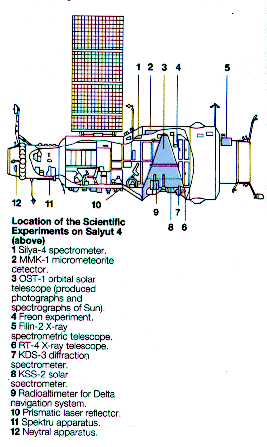Soviet Space Stations: Salyut 4

Cutaway for Salyut 4, with the conical telescope housing visible in the aft compartment (source)
Salyut 4 (or DOS-4) reaped the momentum of the lessons learned from the previous stations, and was quite a success. It was the final iteration of the first-generation Salyut stations, an exact copy of DOS-3 (Kosmos 557) which had failed to reach orbit, with the most visible difference from Salyut 1 being the trio of solar panels relocated to the front compartment.
Salyut 4 Design/Scientific Equipment

List of all the scientific equipment onboard Salyut 4 (source)
Salyut 4 carried a lot of new instruments, as seen in the image above. It had a new on-board navigation system that could keep its position without the aid of ground stations. The three larger solar panels could be independently controlled and produced far more power than the Soyuz-derived ones on Salyut 1. Salyut 4 was also the last of the four DOS stations derived from Almaz hulls, with the following Salyut stations using a more purpose-built design.

Salyut 4 used a different, more flexible fairing shape than the previous Salyut and Almaz stations, that came to be the standard for the rest of the DOS stations (source)
The Mission
Salyut 4 was the first Soviet station successfully visited by two separate expeditions. After its launch at the end of 1974, the first crew (Soyuz 20) arrived in January 1975 in a Soyuz 7K-T, a dedicated station ferry without solar panels. Soyuz 20 stayed for 29 days; their work mostly consisted of operating the array of telescopes on-board, testing station equipment, exercising, and contacting mission control via relay satellite.
Soyuz 18a launched a few months later, but suffered a launch abort. They were followed next month by Soyuz 18, which rebooted the station after its vacancy and performed experiments with growing plants, staying for a total of 63 days. At the same time, Soyuz 19 was carrying out the Apollo-Soyuz Test Project, so it was the first time Soviet mission controllers had to execute two missions at once. Near the end of Soyuz 18's mission, the station was clearly starting to degrade, with the windows fogging over and green mold growing all over the interior.
Several months later, Soyuz 20 was launched unmanned and remained attached to Salyut 4 for three months as a long-duration test of spacecraft and station systems. It deorbited in February 1976, and the station itself followed a year later in 1977.
Salyut 4 front aspect


Comments
Post a Comment